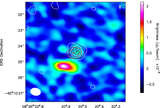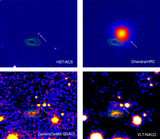Image Details

Caption: Figure 2.
Vela pulsar SED from the radio to the γ-rays. The radio data (filled inverted triangles) come from Manchester et al. (2005), Johnston et al. (2006), Keith et al. (2011), and S. Johnston (2017, private communication). The open triangles with the error bars are our ALMA data (see Table 1). The rest of the spectrum is built from measurements collected from the literature (see Danilenko et al. 2011; Zyuzin et al. 2013, and references therein). The dotted–dashed line is the extrapolation of the near-UV–optical–near-IR PL spectrum (Zyuzin et al. 2013) toward the ALMA bands. The dashed line is the best-fit PL plus exponential cut-off γ-ray spectrum derived from the Fermi data (Acero et al. 2015).
Copyright and Terms & Conditions
© 2017. The American Astronomical Society. All rights reserved.





